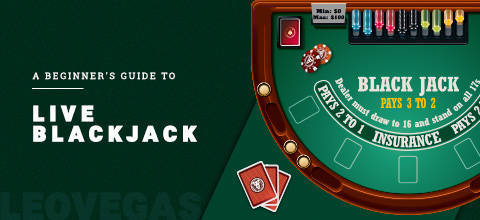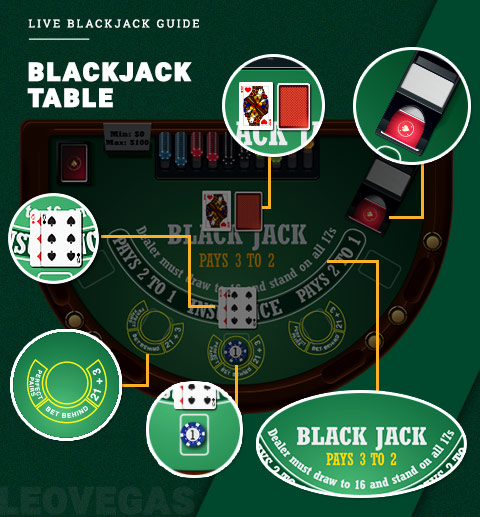
How to Play Blackjack Online
From its early days in land-based venues to its widespread adoption online, the game of blackjack has continued to attract new enthusiasts with its straightforward structure and timeless appeal.
At first, the rules can appear daunting, but they follow a clear logic once understood. This guide will walk you through the essentials, showing how blackjack works in an online setting and what to expect when you sit down at a digital table.
What To Know Before Playing Blackjack Online
Before exploring the rules in detail, it’s important to understand the fundamentals that form the basis of the game. This foundation will make the step-by-step rules of how to play online blackjack easier to follow later on.
Types of Online Blackjack Games
At LeoVegas, you can choose between two main versions of online blackjack: virtual tables and live dealer games. Both follow the rules for online blackjack, but the format differs in how the action unfolds.
In virtual blackjack, computer software powered by a random number generator deals the cards and settles each hand. You play at your own pace, without other participants at the table. The deck reshuffles instantly after every round, which prevents tactics like card counting. These games run around the clock and usually move faster than live formats.
Live dealer blackjack features real cards and professional dealers streamed in high definition. You make your decisions using on-screen controls while the dealer handles the cards in real time. You can also use the chat to greet the dealer or interact with other participants, adding a social element that is closer to what you’d find in a land-based casino.
Essential Terms for Blackjack
Blackjack comes with a handful of core terms that every participant should recognize before sitting at a table. Knowing these will make it easier to follow the flow of the game and understand the choices available to you.
- Hit: Asking for another card to improve your hand
- Stand: Keeping your current total and ending your turn
- Double Down: Increasing your wager after the first two cards and receiving one additional card
- Split: When dealt two cards of the same value, you can divide them into separate hands by matching your original stake. Each hand is then played independently
- Bust: Going over 21, which ends the hand in an automatic loss
- Dealer: The person, or in virtual games the software, that manages the cards and represents the house
- Surrender: Choosing to give up your hand in exchange for half your stake. This option is not always available, but it can reduce losses against a strong dealer card
- Push: A tie between you and the dealer when both hands have the same total
- Soft Hand: A hand consisting of an Ace that can be valued as 11 without going over 21. For example, Ace-6 counts as a soft 17
- Hard Hand: A hand without an Ace, or one where the Ace can only count as 1 to stay under 21
The Goal of Blackjack
The aim of blackjack is to form a hand that finishes closer to 21 than the dealer’s without going over. Reaching exactly 21 is not required; any total that stays below 22 and beats the dealer’s count wins the round. If your cards exceed 21, the hand is a bust and ends immediately.
Because your decisions come before the dealer reveals their full hand, strategy often depends on the dealer’s visible card.
A weak upcard, like a 2 through 6, increases the chance of the dealer going bust, so it’s often wiser to stand on a moderate hand rather than risk taking extra cards. When the upcard is strong, typically 7 through Ace, it can be better to aim higher to stay competitive.
Learning the Rules of Online Blackjack
The following steps outline how to play online blackjack from the first deal to the end of a round.
- Select a chip value and place your bet before the cards are dealt
- You and the dealer receive two cards. Yours are face up; the dealer shows one and keeps one face down
- Total your cards: numbers count as their value, face cards count as 10, and Aces count as 1 or 11
- Compare your total with the dealer’s upcard to decide your next move
- Select Hit to take another card; repeat if needed
- Select Stand to end your turn and lock your total
- Use Double Down to double your bet and take exactly one more card (available only as your first decision)
- Use Split when dealt two cards of the same value to create two hands by matching your original wager; play each hand in turn
- If your total exceeds 21, you bust and the hand ends
- The dealer reveals the hidden card and draws until reaching at least 17. Some tables require the dealer to stand on all 17s, while others have the dealer hit on a soft 17, so always check the specific rules in play
- If your total beats the dealer’s without going over 21, or the dealer busts while you do not, you win the hand
- If both totals match, it’s a push and your stake is returned
Considerations for Online Blackjack
When learning how to play blackjack online, it helps to keep in mind that digital tables introduce a few differences from traditional casino play. Being aware of these details makes it easier to know what to expect before joining a game.
How Online Blackjack Lobbies Work
Online blackjack lobbies, like the one at LeoVegas, give you access to the tables in much the same way as a casino floor. When you open the lobby, you’ll see a list of tables along with details like table limits, the number of seats, the rules in use, and the type of game variant available.
Once you take a seat, betting is handled through an on-screen interface. Virtual chips usually appear at the bottom of the screen, and you select a value before clicking on the betting circle to place it. You can adjust your stake by adding or removing chips, and some tables include a countdown timer to show how much time remains before the next hand begins.
In live dealer games, a chat box allows you to interact with the dealer and other participants.
Messages are displayed on screen, and the dealer often responds verbally, sometimes addressing you by your username. The main view shows the table layout with your position marked, your cards in front of you, and the dealer’s cards at the top. Running totals update automatically, and you can see the outcomes of your own decisions alongside the hands of other participants.

Select the Right Game For You
One of the main appeals of online blackjack is the variety of formats on offer. While many land-based casinos provide only a limited selection, online platforms host numerous versions of the game.
Each follows the same core objective but introduces distinct rules or features that influence how a hand unfolds.
- Classic Blackjack: Often called American Blackjack, this version pays 3:2 on a natural 21. The dealer typically stands on 17, and the rules remain close to the traditional game
- European Blackjack: The dealer begins with one card face up and does not draw the second until after participants have acted. This rule creates a slightly different rhythm compared to the American format and is commonly referred to as the “no hole card” rule
- Vegas Strip Blackjack: Usually played with multiple decks. The dealer often stands on soft 17, and you can typically double down on any two cards, as well as after splitting. These rules promote a quicker pace and encourage more active decisions
- Atlantic City Blackjack: Often played with eight decks. This format usually includes late surrender, which allows a hand to be folded after the dealer checks for blackjack, returning half the stake. Doubling after splitting is generally permitted
- Spanish 21: Played with six or eight decks that omit the 10-value cards. This version often permits late surrender and includes special returns for specific combinations, including certain multi-card 21s
- Blackjack Switch: You play two hands at the same time and can switch the top cards between them to improve your totals. A key rule is that when the dealer finishes on 22, the hand ends in a push instead of a bust
Common Mistakes to Avoid in Online Blackjack
Recognizing frequent mistakes is just as valuable as learning the correct decisions.
Understanding these errors will help participants approach each hand with more confidence and avoid choices that weaken their position.
Not Checking the Rules and Payouts
Online blackjack tables often differ in the rules they follow. Some return 3:2 on a natural blackjack, while others return 6:5. Certain tables require the dealer to stand on all 17s, whereas others have the dealer hit on a soft 17.
Skipping over these details can leave you at a disadvantage without realizing it. Taking a moment to review the table information ensures you know exactly how that version of the game is structured before committing your stake.
Playing Without Basic Strategy
Blackjack is not purely a game of chance. A recognized basic strategy outlines the statistically sound move for every type of hand. Ignoring it often leads to choices that increase the house edge. Even becoming familiar with the core elements of the chart helps reduce mistakes and improves your overall results.
Taking Insurance
When the dealer shows an Ace, the table may offer insurance. Although it appears to provide protection, the odds rarely justify the choice. The chance of the dealer having a 10-value card in the hole is too low to make insurance worthwhile.
While it may succeed on occasion, over time it reduces returns rather than improving them. If the dealer does have blackjack, the main hand is lost regardless, and the insurance stake only adds to the overall setback.
Misusing Double Down and Splits
Doubling down and splitting are strategic moves that can significantly impact the outcome of a hand when applied correctly. Many participants either avoid them altogether or use them in the wrong situations. Doubling down with a total of 11 against a weak dealer upcard is often effective, and understanding when to divide a pair of 8s is equally important.
Splitting Tens
Two 10s create a total of 20, which is already among the strongest starting hands in blackjack. Splitting them may seem appealing, but it generally weakens your position.
By dividing the pair, you give up a high-value total for two separate hands that are less likely to reach the same strength. Keeping the 20 is almost always the sounder choice, as it preserves one of the most reliable hands available.
Learn more about blackjack and other casino games in our guides:
- Common Mistakes in Blackjack
- Blackjack Strategies
- Blackjack Etiquette
- Blackjack Decks
- Blackjack Odds
- Double Deck Blackjack
- 21+3 Blackjack Side Bet
- Blackjack Hands
- How To Win At Blackjack
- Blackjack Card Values
- Spanish 21
- American Blackjack
- Blackjack Surrender
- Blackjack Glossary
- Blackjack Insurance Guide
- Bet Behind Blackjack
- Blackjack Side Bets
- Common Mistakes in Blackjack
- Roulette Strategies
- Canadian Card Games
- Atlantic City Blackjack
- Roulette Bets
- How to Win on Online Slots
- How to Win at Baccarat
- American Roulette
- How to Play Roulette Online